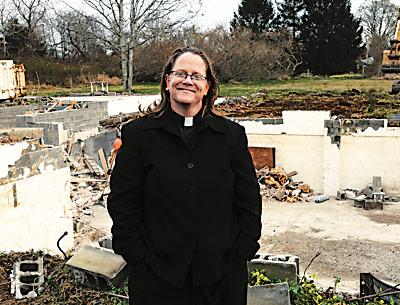Plea for Dune Walkway and Stairs
Plea for Dune Walkway and Stairs
The East Hampton Town Zoning Board of Appeals considered an application on Nov. 29 to construct stairs and a walkway to the ocean beach from a house at 241 Marine Boulevard in Amagansett. The applicant, Brian Maher, is appealing a decision by Tom Preiato, the senior building inspector for East Hampton Town, denying the project. In addition to a reversal of the decision, Mr. Maher is seeking a natural resources permit, but argues that he does not need a variance for the construction.
Brian Matthews, counsel for Mr. Maher, spoke on his behalf. His client had initially applied in May 2010 for an elevated walkway two feet above ground as well as stairs from his oceanfront house. At the time, according to Mr. Matthews, the East Hampton Town Planning Department would not review the application because a similar application, involving an easement, had been denied in 2000.
A neighbor subsequently received a certificate of occupancy for similar construction, which prompted Mr. Maher to resubmit his application, Mr. Matthews said. Following correspondence in March, the applicant was informed that he would need a variance because stairs and walkways are not exempt from prohibitions on coastal structures.
“The Planning Department and my office went to the building inspector to discuss the stairs with him. All they do is access the walkway,” Mr. Matthews said. He said they were told the stairs needed to meet zoning setbacks and if the stairs were connected to a deck on the house, a natural resources permit would not be needed.
The result would have been a 12-foot-high walkway. His client opted instead to apply for a variance.
“The application for the stairs meets the relevant variance criteria,” Mr. Matthews said, adding that the application had already received State Department of Environmental Conservation approval. “It’s less than four feet wide, and we eliminated the platform at the southern end,” he said. There is a public walkway nearby, but Mr. Matthews said, “You purchase oceanfront property, you have the right to access the ocean.” He also said connecting to the public walkway would cause a greater disturbance.
Mr. Matthews said there would be no negative environmental impacts and that it would not affect adjacent properties, which all have similar walkways.
Tyler Borsack, an environmental technician for the Planning Department, told the board that reversing Mr. Preiato’s decision would set a precedent. “The stairs are not part of coastal structures” as identified in the town code, he said. Connecting to the public walkway was a reasonable alternative as would be connecting a new walkway to the deck, added Mr. Borsack.
The board will come to a decision in the next few weeks.



